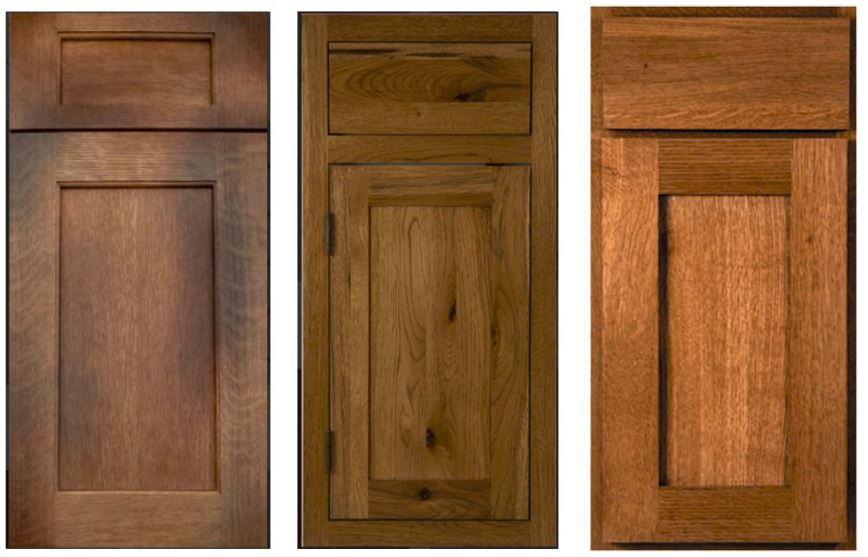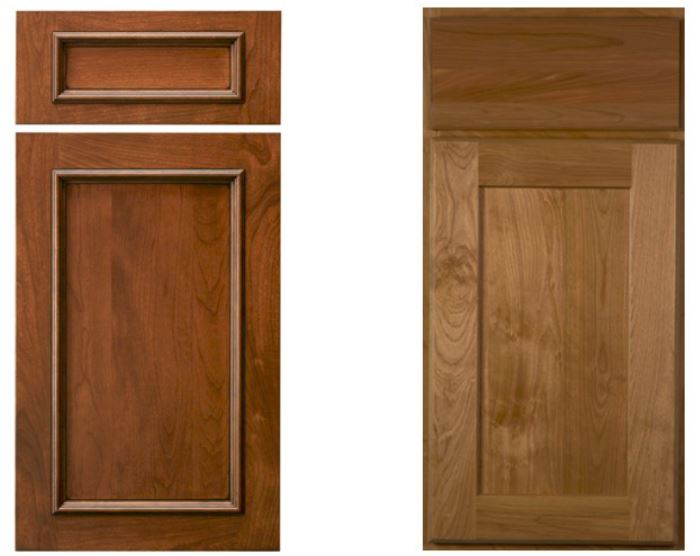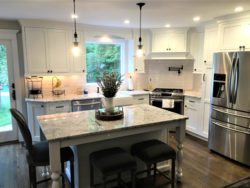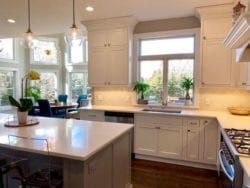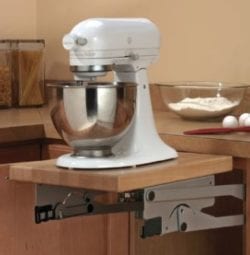Selecting Cabinet Doors for a New Kitchen
The one thing that will affect the look of your new kitchen perhaps more than anything else is the style of your cabinet door and drawer fronts. And there are many styles available to you! Traditional 5-piece, slab, or mitered construction. Raised or flat (recessed) panels. Ogee, square, or regular beads. And more… So many choices.
I’d like to take a moment to help parse out the details. We’ll look at the different types of construction, the options for material, edge, bead, and panel profiles, and some other door and drawer choices that may interest you.
Door Construction
There are three main types of door construction:
- Traditional (also known as mortised or cope and stick)
- Mitered
- Slab
Traditional Doors
A door or drawer called “Traditional” is made up of five pieces, which is why they are sometimes called “5-Piece doors” or “5-Piece drawers”.
Think of this type of door as a picture frame that has a top and bottom rail (the horizontal members of the frame), a left and right stile (the vertical members of the frame) that together house a center panel (which is where the glass would be in a picture frame).
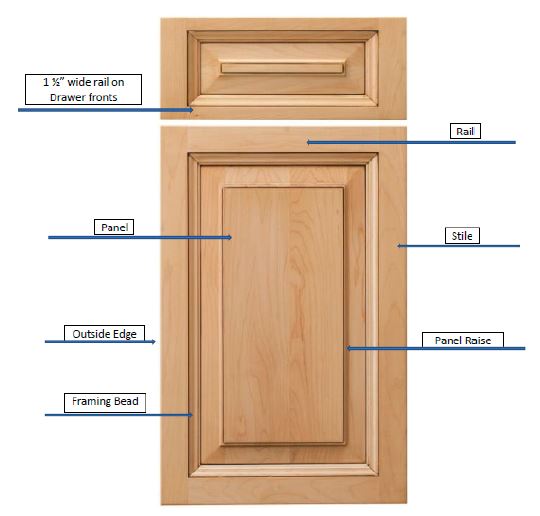
For detail on the door frame, you will choose the outside edge profile and the inside edge profile, called the framing bead. That’s not all – you get to choose either a raised or flat center panel. If you select a raised panel, then you will have to decide on the raised panel profiles from a number of options.
Don’t worry. I’ll walk you through all the available options when designing your new kitchen. I’ll show you samples and demonstrate how the different profiles and panel raises change the look of the door and drawer.
Mitered Doors
A mitered door also has five pieces, but on this type of door, the corners are mitered together. A mitered corner is created when the two pieces that get joined together (the door stile and rail) are both cut at a 45-degree angle to form a 90-degree corner. Here’s a photo that shows what I mean.
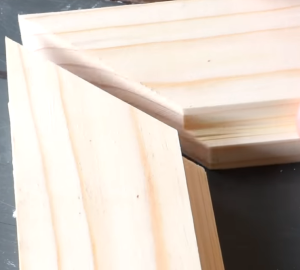
The term “mitered” when used to refer to cabinet doors only describes the joining method. It doesn’t say anything about the style of the doors. Mitered doors come in many different styles, from classic to contemporary.
Mitered doors offer a greater style selection than 5-piece doors and drawers. They come in hundreds of different styles. Their one limitation is that mitered doors can’t be used on inset cabinetry in a new kitchen.
If you choose a mitered door style and want painted cabinets, I recommend a door with a frame that is 3 ¼” or less, as the miters may open with seasonal temperature and humidity changes. This is normal but something to keep in mind.
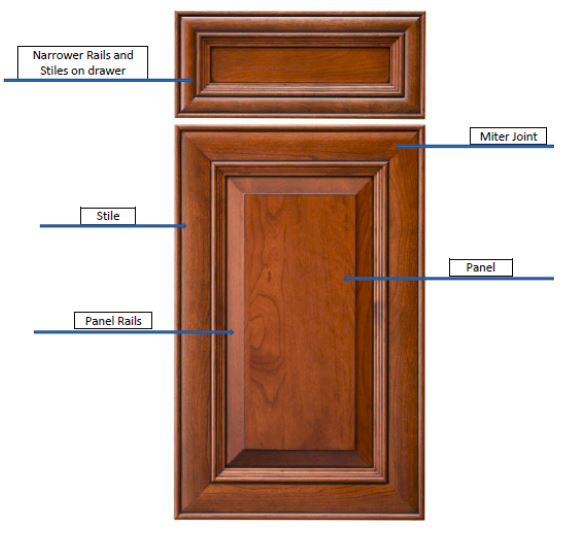
Doors with Applied Molding
Applied molding doors have a separate piece of moulding attached to each part of the door frame. These moldings can be simple or more ornate, like rope, egg-and-dart, or other carved mouldings. Doors with applied mouldings tend to be more elaborate, but simpler designs are available as well. They also cost a bit more than other door styles.
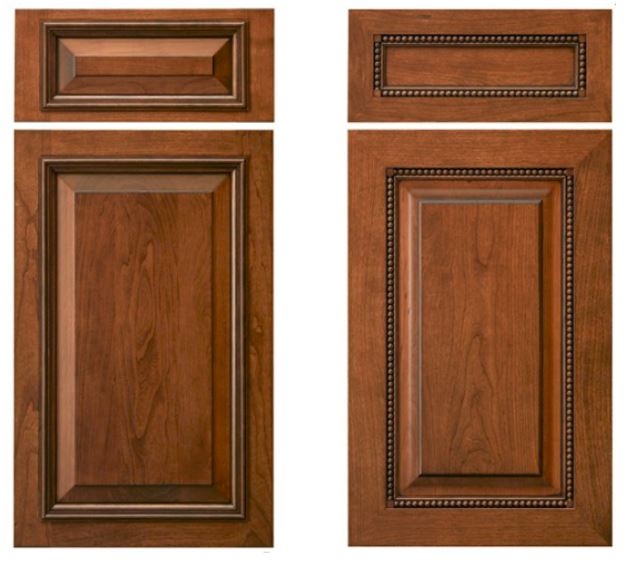 Slab Doors for Your New Kitchen
Slab Doors for Your New Kitchen
A slab door has a flat, smooth door front. There are two basic methods to building slab doors:
- glued-up solid wood
- sheet goods
Often slab doors will have a square outside edge, although on a solid wood door, you do have the option for a shaped outside edge.
With a glued-up solid wood door (#1 above), the manufacturer glues narrow pieces of wood together to form a larger door. It gives the door a warm, deep, natural look that many people –including me — like.
I recommend that a batten is used when this style is chosen as it helps keep the door stable with seasonal changes in humidity levels. A batten is a solid strip of wood fastened on the back of the door. This will help keep the door from warping during regular seasonal temperature changes. The photo below shows battens on the back of a cabinet door. Different cabinet makers have different ways of attaching battens. They don’t all look like this, but it gives you an idea.

Sheet Goods Door
If you don’t like battens, you may want to consider a door made from sheet goods (#2 above).
A sheet goods door is plywood or MDF with a veneer front (face) and back. The sides are edge-banded to match the finish. The advantage to this method of building a door is battens aren’t needed. Plywood and MDF are very stable and won’t warp.
Although, in my opinion, there is not as much “life” or depth to veneer as there is in solid wood doors.
One way to create visual interest in your new kitchen is to ask for sequential matching when you pick veneer doors. The cabinet manufacturer will use the same piece of veneer on all the doors and drawers that butt up to each other. When the cabinets are installed, it creates a unified, streamlined look — very contemporary.
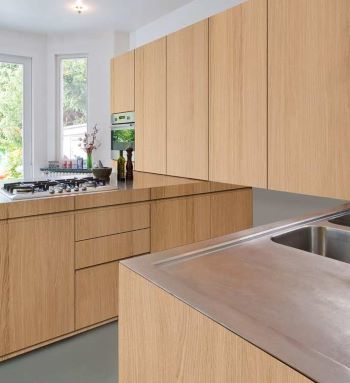
Here’s two examples of slab doors and drawers. The photo on the left shows a slab door and drawer with square edges. The photo on the right shows a slab door and drawer with vertical stiles that contrast with the horizontal grain in the panels.
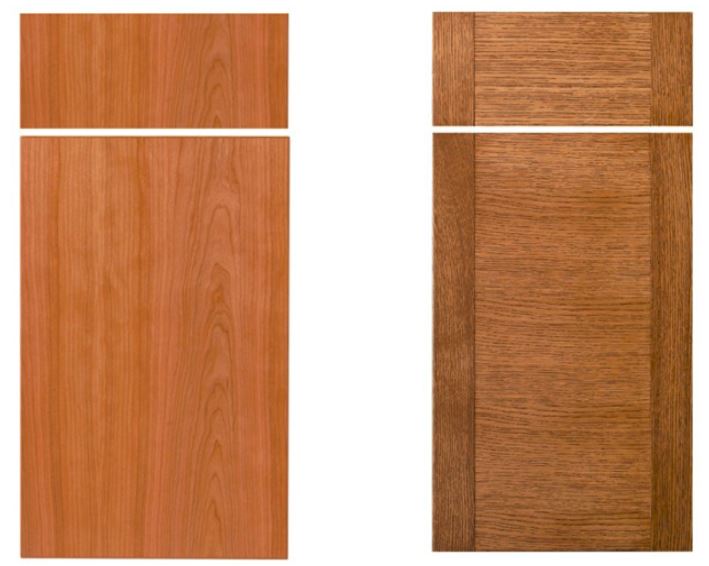
Aluminum Doors as Accent in New Kitchen
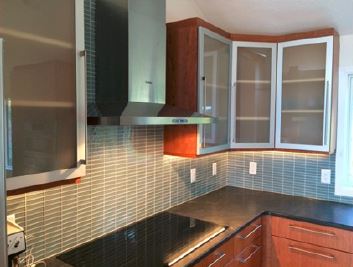 Aluminum doors are popular as accent pieces in kitchens and other spaces, such as game rooms and bars.
Aluminum doors are popular as accent pieces in kitchens and other spaces, such as game rooms and bars.
They add an element of interest and draw your eye to a cool, modern touch.
They can be fitted with clear glass, or any number of specialty glass types, such as frosted, reeded, or water glass, among others.
Drawers
A standard drawer will have a 2 ¼” frame, but there are many options for drawers with frames as wide as 4”. And even wider!
Something to keep in mind is that shallower drawers, such as top drawers, will have a 1 ½” top and bottom rail. The stiles will match the stile width of the doors.
Mitered drawers will also have a smaller frame, usually 1 ½” on both rails and stiles. Also on the same drawers, you should be careful about using a raised panel as you can quickly run out of space for your drawer pulls. Consider using a flat panel instead.
While we are talking about flat panels, high end, custom cabinet manufacturers, like Brighton, will use a 3/8” center panel. This accomplishes two things:
- It gives doors a more solid feel. Manufacturers that use lower quality materials in their cabinets use ¼” thick flat panels, which feel light and flimsy.
- When the drawer hardware is installed on a ¼” flat panel, the screws will “suck” the panel into the drawer box and the panel will bow. This will not happen with a 3/8” thick panel’.
Some people prefer the look of a flat, smooth, slab drawer front in their new kitchen. Others feel slab drawer fronts are too “plain looking” when compared to a 5-piece drawer. In my opinion, once you install a nice drawer pull, it no longer looks “boring”.
If you choose a slab drawer front, I definitely recommend using 5-piece drawers for the bottom drawers in your drawer base cabinets when your doors are 5-piece doors.
A drawer front option that will work with raised panel doors is a 1 ¼” thick slab drawer with the and outside edge profile that matches the door panel raise.

Materials Used for Cabinet Doors and Drawers in a New Kitchen
Today about 70% of cabinetry is painted. Often painted doors are made from Maple with an MDF center panel. Some people react negatively when I mention the MDF panel, but be assured this is a great material for center panels as it does not warp, swell, or separate the way solid wood, or even plywood, can.
You can even go one step further and have a door made completely from MDF, which is great because the joints where the stile and rail meet will not have any “cracks” in the paint as can happen with solid wood.
If you like the look of stained cabinetry, you can have your choice of many wood species, such as Cherry, Maple, Oak, Rift or Quarter Sawn Oak, Walnut, and Alder. Renewable products such as Lyptus and Bamboo are available, as well as exotics like Zebra or Cocobolo, and on, and on, and on.
Most Popular Door Styles for New Kitchens
In this age of Transitional design, doors with simple lines and flat panels rule. I would like to finish this article by showing you the doors my customers choose most often. Notice that they are simple in design with straight, pleasing-to-the-eye lines to complement today’s popular Transitional style. These doors fit in well with a kitchen that is dressed up or simple and understated. Enjoy!
